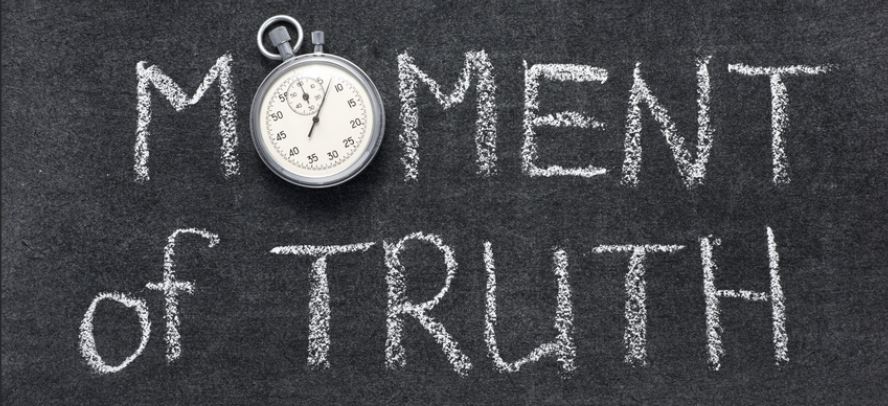The Audacity
Jul 27, 2022
One of the stories that I loved in the book Big Magic (and I loved a lot of them) was the lobster story. Seriously, even thinking about it now warms my heart and makes me feel like the world is a good place. The author, Elizabeth Gilbert, tells a story she heard when talking to a stranger in coffee shop. A story about this man's little brother who was invited to attend a frivolous foreign affair. I know, I know, at first blush it sounds like a real snoozer, but it’s so not a snoozer.
Apparently, this little brother was an aspiring artist who traveled to France to gain both information and inspiration—like why you read this blog but without the croissants and berets. As the story goes, one day this fine chap met some young aristocrats in a café and struck up a convo with them about his art. They took a liking to him and invited him to a boujee masquerade ball the following weekend. They emphasized that elaborate costumes were a hallmark of this soiree and encouraged him to dress up and be their guest.

Wow, what a day! As an aspiring artist, he longed for a chance to meet the rich, the famous, and the connected. So, he gladly took them up on their offer and scoured France for the detailed materials he would need to concoct an elaborate costume using some of his own creative moxie. And that’s exactly what he did as he crafted his very own one-of-a-kind costume. He then rented a car and drove three full hours to the castle from Paris. He changed into his costume in the car, approached the castle to find his name on the invite list, and was welcomed into this grand masquerade ball.
It was then that the previous miscommunication he had had became abundantly clear. While it was indeed a costume party, it was a themed costume party, the theme being ‘a medieval court’. Said little brother was dressed as a lobster. There, in the middle of France, in an elegant castle surrounded by the upper crust dressed to the nines in their medieval court attire stood this creative little brother in the brightest, reddest crustacean costume your mind can imagine. Think full body tights and ginormous foam lobster claws. Heck, he had even painted his face red—he was an artist after all! This 6 foot tall American would have stood out no matter what. But with a full-body costume harkening the color of the embarrassment you’d likely have on your face, he debated whether to fully enter the venue or not. What would you do?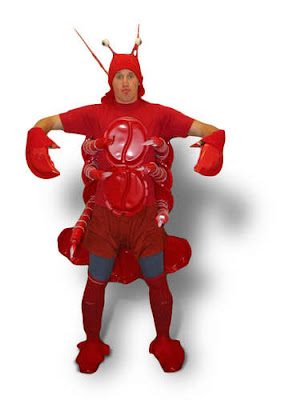 He had worked all week on this costume. And he had driven 3-hours to get to the party. So, he took a deep breath, followed the music, trusted his gut, and entered the venue. The audacity! Hundreds of aristocrats suddenly turned their eyes toward the lobster and a silence fell upon the room. The dancing stopped. The music stopped. The conversation stopped. Then, some brave soul asked, “What on earth are you?” Without skipping a beat, he bowed and introduced himself as the Court Lobster. Laugher ensued. But not laughter at him--he wasn't the Court Jester after all--laughter with him. It was utter boisterous joy!
He had worked all week on this costume. And he had driven 3-hours to get to the party. So, he took a deep breath, followed the music, trusted his gut, and entered the venue. The audacity! Hundreds of aristocrats suddenly turned their eyes toward the lobster and a silence fell upon the room. The dancing stopped. The music stopped. The conversation stopped. Then, some brave soul asked, “What on earth are you?” Without skipping a beat, he bowed and introduced himself as the Court Lobster. Laugher ensued. But not laughter at him--he wasn't the Court Jester after all--laughter with him. It was utter boisterous joy!
He was the life of the party. Clearly the only Court Lobster they’d ever seen and certainly the only Court Lobster to dance with the Queen of Belgium. And that’s what we marketers do, too. In the most left brain and right brain ways, we use the knowledge we've obtained and the tools at our ready to create. Then we walk right into that play-by-the-rules philanthropic party and we dance.
Left Brain Marketing Methods: Our left brains tell us follow all the rules. We ask the questions; we heed the answers. We’ll want the invite to the party and we’ll even go, but not to stand out. And that can serve us well. After all, even parties have guidelines that we all follow. They’re unwritten rules, but rules just the same. Knowing them will help you speak to your donors. So, let’s learn them and use them to expand your mission.
Right Brain Marketing Moxie: We were created to be creative. And you definitely don’t want to be the lobster that walks away out of fear or embarrassment. Creating new things or launching new ideas into old environments will make you feel like a bright red lobster in a medieval court-themed masquerade party. But I know this one thing for sure—you simply cannot miss the party. Let’s find out how to do that in the medieval castle of philanthropy.
Let’s all find our lobster!
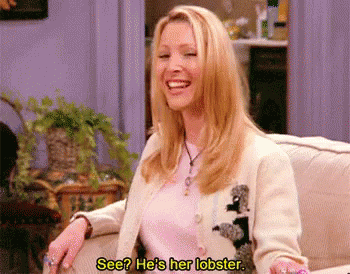
Left Brain Marketing Methods: Whether you know you know them or not, there are party rules—and you follow them. In Influence is your Superpower, author Zoe Chance talks about those rules. You enter the party fashionably late and you know what to expect. Do you expect the hostess to stop everything and greet you? No. Do you expect the music to stop so the party-goers can welcome you a full room greeting like Norm from Cheers? Also no. Do you stand at the door until someone invites you to join a group and compliment your outfit? Again, no. We know what to do. We walk in and approach a group listening intently to a hilarious (apparently) story. You don’t stop their story to tell your own or force them to stop and provide backstory or introductions. You inch in. Like when you used to hop in as the jump rope would swing toward you. You'd wait for the right moment and you'd join the flow. And when the time comes, you could introduce yourself or tell your own hilarious story or participate in the volley of frivolous banter. It’s a party after all, that’s what you do. That’s what happens at a party. It’s party etiquette.
What’s this have to do with nonprofit fundraising and marketing, you might be asking yourself? Well, everything! There are party rules. But there are also fundraising marketing rules. After all, you’re trying to get the attention of your donors—but they’re already in the middle of their own party. This party is called their life but the rules still apply. They get to decide if they greet you immediately, introduce you to someone else, or stop their story to invite you into the fold.
Chance states, “When you ask can sometimes matter more than how you ask or even what you’re asking for.” Just like the party flow or the jump rope rhythm, timing is everything. You need to use what you know about the flow of life to determine when your donor will be most open to your influence. When is what you’re about to say most relevant? Keep in mind, sometimes you’re thanking them—when is a good time for that? A full report might be lengthier, when would they have the time to read that? And you’ll make many asks; when would the most significant time to make those? You know your donors; use that information to your advantage.
I’ve already given you the example of Surprising our Tax-Accountants with Gratitude the week of April 15th—they’re exhausted and truly appreciate the sincere thank you. Some of you believe that Giving Tuesday is a great opportunity to make an ask for your organization—and perhaps it is. They certainly are expecting to be asked on Giving Tuesday. Perhaps you know that making that ask at the time will be fruitful. Or maybe you worry that an ask near Giving Tuesday will only be divided by the other dozen asks they receive at that time. Only you truly know the best timing for your donors. Remember, the party you’re interrupting is their life. You’ll weave in and out of their life for years, even decades, if you do this philanthropic dance well. Sure, you may enter as the Court Lobster, but who doesn’t need to create another marvelous core memory anyway?

Right Brain Marketing Moxie: In Chance’s book she talks about her second favorite marketing campaign of all time. And I loved this section because this is a marketing campaign that happened to me in real life! One time many moons ago, our local Main Street organization nominated me as Main Street Volunteer of the Year. We had been working on a new downtown beautification project and had garnered the support of many volunteers and donors to pull it off. It was lovely. As part of their thank you to me, two of their most amazing and creative generosity bandits, graffitied the entrance to our office. They literally created a stencil of gratitude and painted it outside of our building on the sidewalk with a water-repellent spray. So, on any given hot day, you’d never notice it. But anytime it rained, the water-repellant words of gratitude were vivid. It was so clever, abundantly appreciated, and it lasted for years. The sort-of-secret message grabbed a lot of attention because it was unexpected and unusual. Chance calls this a Moment of Truth and she defines this as a time or place when your donor would be most likely to be open to your influence.
Although I’m just introducing this to you today, you’ve always known it. As a kid, you’d never ask your dad for gas money if he came home in a bad mood—you’d wait until the right time. Every high school student knows this! Timing applies to the right brain moxie you integrate into your marketing messages as well. That’s why current events, issues donors are already paying attention to, or a moment of truth you create on your own (like this fun matching campaign we did once upon a time) are important hooks to hang things on. Check out this ‘toilet paper math’ matching postcard we sent. The audacity. I love this one because it’s quirky and who would think you’d ever bring toilet paper into a donor communication piece. But at the height of Covid, toilet paper was a big deal—everybody was paying attention to it. And toilet paper math is complicated, even if no one is talking about it—much more complicated than the matching campaign we had going on. The comparison was great and something everyone could relate to at that time.
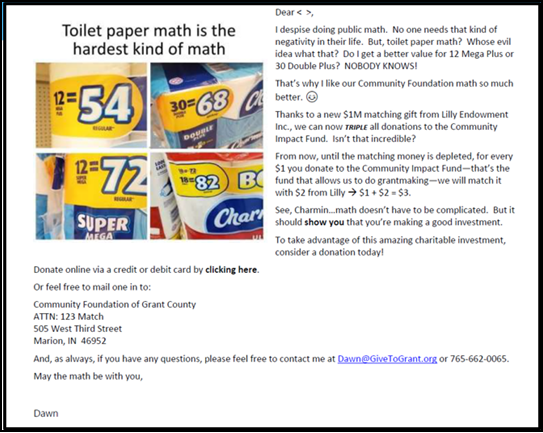
Chance recommends executing the Implementation Intention to “activate the power of timing”. She says that the Implementation Intention is answering the question, “Okay, so when and how are you going to do that?” See, timing really is everything. Instead of pestering your donors to act at the wrong time, you seek the most relevant time for them. You jump into their party conversation at just the right moment where you’re not interrupting, you’re simply joining the flow.
Marketers were created to be creative. Yet, some still believe that philanthropic endeavors are stale, staid, and suburban. And if that’s working for you, then great—go on with your bad self. But if you’re in a rut, and the times have changed just enough that the next generation of donors would not only welcome a Court Lobster into the party but would also dance with him, then be the lobster! After all, everyone is still talking about that lobster. And that’s marketing mileage, my friend. It’s also a great way to create that secondary marketing department which is that group of donors who tell your story to others that might have both an affinity for your org and the capacity to do something about it. Because that creativity that you have--you know that thing that makes you excited and vulnerable and absurd all at the same time?--is special. It's a gift that gives you a license to trust your gut and wow your donors. I like to call it…The Audacity. Do you have the audacity? An intrepid boldness that is admirable? If you've read this far, you do. Use it.
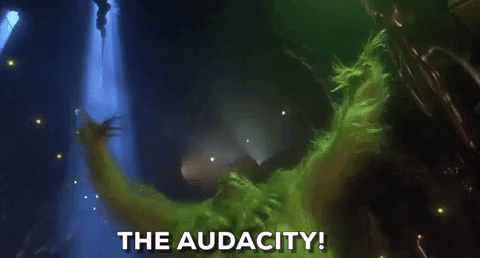
All My Best,
Dawn
[email protected]
dawn brown creative, llc.
P.S. Fundraising is hard, even though you make it look
oh-so easy! ♥
Frideas--Friday ideas are filled with
info and inspo!
Want to participate in some Knowledge Generosity,
here's your opportunity!
What do you do with an idea? You change the world!
Stay connected with news and updates!
Join my mailing list to receive the latest news, updates, and ideas for days!
Don't worry, your information will not be shared.
I seriously hate SPAM, like for real.
So, I promise to never sell your information, for any reason.



